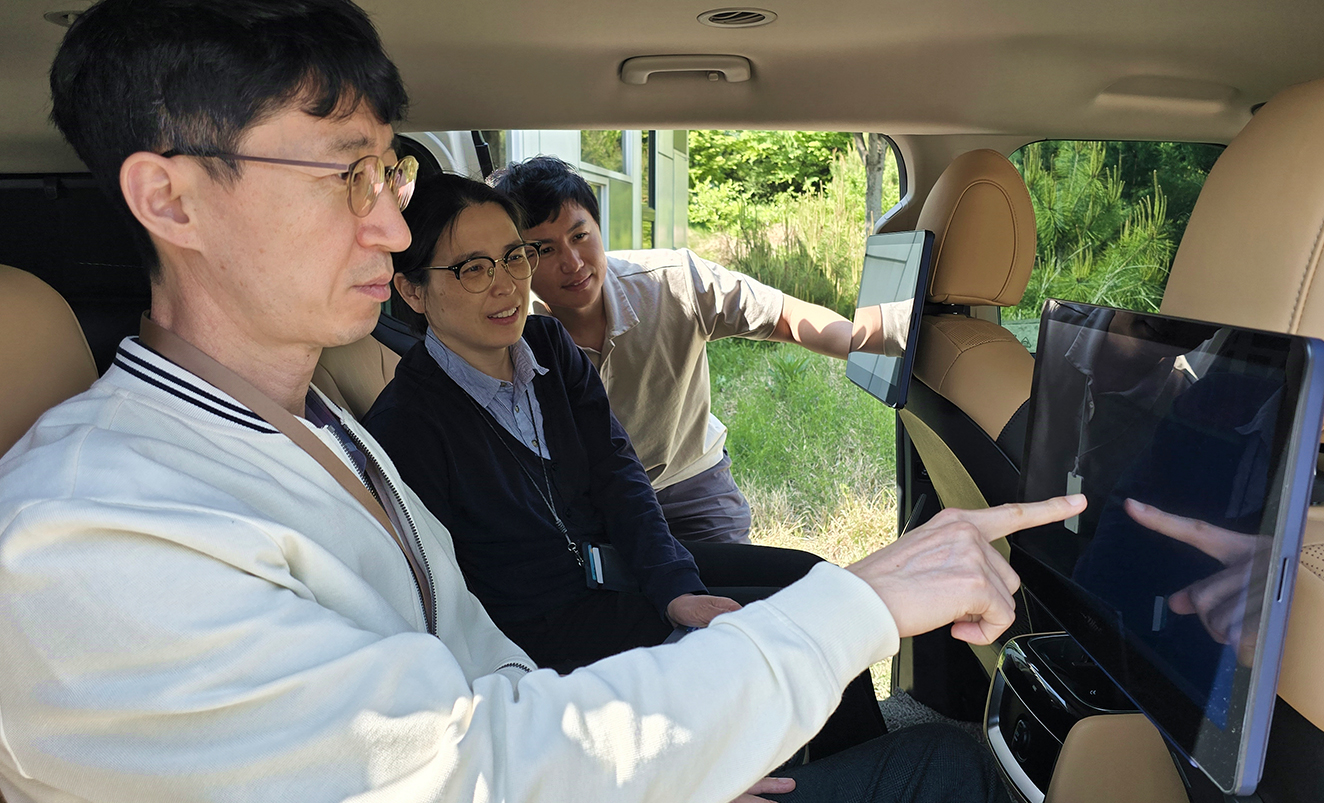ETRI to Develop Heterogeneous V2X Cooperative Driving Communications Technology
Vol.83 June
- “The car speaks and the road answers” Application of autonomous driving demonstration technology in Daejeon City
- Development of 3 types of communication-based cooperative autonomous driving and optimization of vehicle-to-infrastructure communication

Korean researchers will begin developing core technologies for cooperative autonomous driving services using heterogeneous vehicle-to-everything (V2X1)) technology. This will overcome the limitations of safety services that have been limited to vehicles equipped with vehicular communication devices and extend safety services to general vehicles and pedestrians, which is expected to bring about a dramatic improvement in the efficiency and safety of road transportation.
Electronics and Telecommunications Research Institute (ETRI) has announced that it is in full swing to develop next-generation cooperative driving communication technology based on heterogeneous vehicle-to-everything (V2X) technology that enables real-time communication between vehicles as well as cooperation with road infrastructure and mobile communication networks.
The researchers decided to develop three cooperative autonomous driving services, including ▲cooperative driving, ▲cooperative cognition, and ▲remote control, based on communication technology that provides seamless connectivity for general vehicles, pedestrians, and connected (autonomous) vehicles.
This technology connects vehicle-to-vehicle (V2V), vehicle-to-infrastructure (V2I), vehicle-to-pedestrian (V2P), and vehicle-to-network (V2N) on a single, unified platform, and is being recognized as a key infrastructure for the future of autonomous driving. The researchers will use the technology to develop communication and service technologies that can support Level 4+ autonomous driving services.
1) V2X: An acronym for Vehicle-to-Everything, it is a communication technology that exchanges information, including traffic information, with other vehicles and objects for which infrastructure such as roads is built. The information is exchanged through wired and wireless networks while driving.
 Overview of key technologies for heterogeneous V2X-based cooperative autonomous driving services
Overview of key technologies for heterogeneous V2X-based cooperative autonomous driving services
The technology being developed by ETRI is focused on implementing a “heterogeneous converged network-based service platform” that enables real-time data sharing between various infrastructures that use different communication methods, such as vehicles, traffic lights, CCTV, and pedestrians (smartphones).
Major development outputs include: ▲ vehicular communication device (On-board Unit, OBU)2) that provides seamless service between different networks, ▲ autonomous driving system based on different networks, ▲ edge/infrastructure server for cooperative autonomous driving service, ▲ remote control system, ▲ application (safety service) development for pedestrians and general vehicles.
In particular, this study applies bidirectional real-time communication and vehicle control technology in which the vehicle transmits video information with a resolution optimized quality suitable for the varying network conditions, and the road infrastructure and server analyze and judge it based on the received information and send control signals back to the vehicle.
For example, if a vehicle or infrastructure near an intersection recognizes a pedestrian at risk or a traffic accident, it can share this information in real time with neighboring vehicles, allowing them to proactively slow down or stop. This is the foundation for realizing a smart transportation system based on “cooperative interaction among autonomous vehicles, human-driven vehicles, and pedestrians” beyond basic autonomous driving safety support services.
The technology is designed to be flexibly scalable and applicable across various wireless network environments, including 5G, LTE, Wi-Fi, and specialized networks (KREONET). In addition, AI-based network optimization technology and intelligent edge server technology will be developed to enable stable cooperative driving under complex conditions such as vehicle movement speed, communication latency, and video quality.
ETRI expects the technology to be applied to a variety of public services, including reducing traffic accidents in cities, easing urban congestion, and providing priority access for emergency vehicles. ETRI plans to expand the technology to various fields in the future, such as highway group driving, smart city traffic control, and pedestrian notification systems to protect the elderly.
Choi Jeong Dan, assistance vice president of ETRI’s AI Robot Research Division, said, “This research goes beyond simple vehicle autonomous driving technology and is the foundation for ‘collaborative smart mobility’ that connects entire cities. It will be the first step toward creating a safe and efficient transportation ecosystem centered on people.”
The R&D will be conducted from April this year to the end of 2027 as part of the ‘Autonomous Cooperative Driving Technology Development based on Heterogeneous V2X Seamless Communication for Autonomous Driving’ project, which was supported by the Ministry of Science and ICT, the Institute of Information & Communications Technology Planning & Evaluation (IITP), and the Korea Autonomous Driving Development Innovation Foundation (KADIF).
ETRI is the main research organization, the joint research institutes are Korea Electronics Technology Institute, Saesol Tech, Ettifos, Telecommunications Technology Association, and Ajou University Industry-Academic Cooperation Foundation. Demand companies such as Daejeon Metropolitan City, LG Electronics, and Kakao Mobility will also participate in service verification and commercialization, and will lay the foundation for commercialization through demonstrations with domestic telecommunications and autonomous driving solution companies.
The R&D results will be applied to autonomous driving demonstration divisions nationwide, including the Daejeon Autonomous Driving Demonstration Division, which is a demonstration test bed, and are expected to be applied to various fields such as safety (convenience) and remote control (control) services for various road moving objects including autonomous vehicles, ordinary vehicles, and pedestrians, and greatly contribute to the development of new industries.
2) OBU: An acronym for On-Board Unit, it refers to a vehicle communication device installed in a vehicle.
Song Yoo-Seung, Principal Researcher
Autonomous Driving Intelligence Research Section
(+82-42-860-1802, yssong00@etri.re.kr)